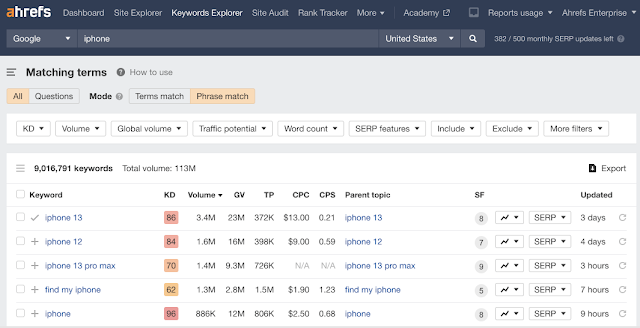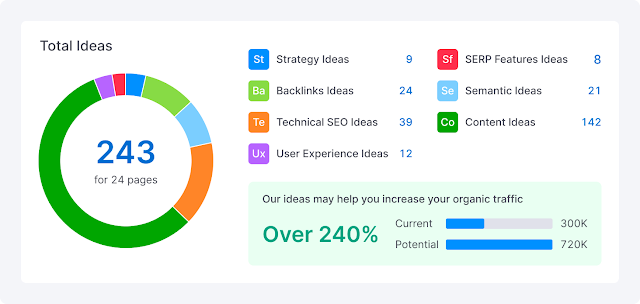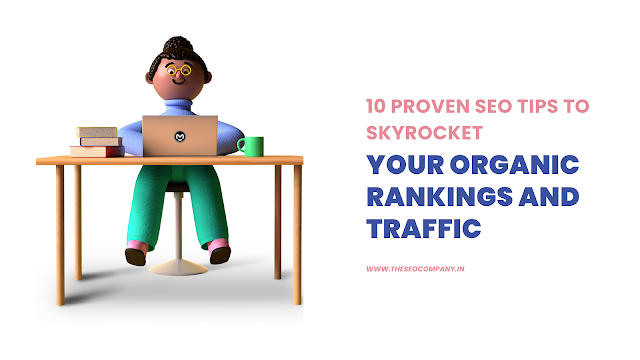Search engine optimization (SEO) is a critical aspect of
online business success. By optimizing your website for search engines, you can
boost your organic rankings and drive more traffic to your site. In this
article, we'll be discussing 10 proven SEO tips that can help you skyrocket
your organic rankings and traffic.
I. Introduction
Search engine optimization is an ever-evolving field, and it
can be hard to keep up with the latest trends and best practices. However, by
following a few simple tips, you can significantly improve your website's
search engine rankings and drive more traffic to your site.
In this article, we'll be discussing 10 key areas of SEO
that you should focus on to boost your organic rankings and traffic. These tips
will cover everything from keyword research and on-page optimization to
technical SEO, link building, and content marketing.
II. Keyword Research
Keyword research is the process of identifying the keywords
and phrases that your target audience is searching for on search engines. By
understanding the search intent and language of your audience, you can optimize
your content to rank for those keywords and attract more organic traffic to
your site.
To conduct keyword research, you can use a variety of tools
such as Google Keyword Planner, SEMrush, and Ahrefs. These tools will help you
identify the keywords that are most relevant to your business, as well as the
search volume, competition, and other metrics.
 |
| Ahrefs |
Once you've identified your target keywords, you should
include them in various parts of your website, such as:
- Title
tags and meta descriptions
- Headings
and content optimization
- URL
structure
Make sure your keywords are included in a natural way and
don't stuff them in unnaturally.
III. On-Page Optimization
On-page optimization refers to the practice of optimizing
individual web pages in order to rank higher and earn more relevant traffic in
search engines.
 |
| SEMrush |
Here are some best practices for on-page optimization:
- Write
unique and compelling title tags and Meta descriptions for each page.
- Use
heading tags (H1, H2, and H3) to structure your content and make it easy
for users and search engines to understand.
- Optimize
your content for both search engines and users by including your target
keywords, but don't stuff them.
- Make
sure your URLs are short, descriptive, and include your target keywords.
IV. Technical SEO
Technical SEO refers to the optimization of the technical
aspects of your website that affect its visibility and ranking in search engine
results pages (SERPs). These include things like site speed, mobile
optimization, and the use of XML sitemaps and robots.txt files.
- Site speed: A slow-loading website can negatively impact your search engine
rankings and user experience. To improve your site speed, you can optimize
images, use a content delivery network (CDN), and minimize the use of
large files and scripts.
- Mobile
optimization: More and more users are accessing the internet via mobile
devices, so it's important to ensure that your website is optimized for
mobile. This includes things like responsive design and mobile-friendly
navigation.
- XML
sitemaps and robots.txt: An XML sitemap is a file that lists all the pages
of your website, making it easier for search engines to crawl and index
your site. A robots.txt file, on the other hand, is used to give
instructions to search engine crawlers about which pages or sections of
your site should not be crawled.
V. Link Building
Link building is the process of acquiring backlinks to your
website from other sites. Backlinks are important because they signal to search
engines that other websites consider your content to be valuable and
authoritative.
To build high-quality links to your site, you can:
- Create
valuable and engaging content that other websites will want to link to.
- Reach
out to other website owners and ask if they would be willing to link to
your content.
- Guest
post on other websites and include a link back to your site.
- Participate
in online communities and forums, and include a link to your site in your
signature or profile.
VI. Local SEO
Local SEO is the process of optimizing your website and
online presence for local search. This includes things like optimizing your
Google My Business listing and getting listed in local directories and citation
sites.
- Optimizing
your Google My Business listing: To optimize your GMB listing, you should
include your business name, address, phone number, and hours of operation.
You should also include high-quality images and encourage customers to
leave reviews.
- Local
citations and reviews: Getting listed in local directories and citation
sites can help boost your visibility in local search results. To get
listed, you should ensure that your business name, address, and phone
number (NAP) is consistent across all these listings.
VII. Analytics and Tracking
Analytics and tracking are important for measuring the
success of your SEO efforts and identifying areas for improvement. Some of the
most popular analytics and tracking tools include Google Analytics, SEMrush,
and Ahrefs.
These tools will help you understand things like:
- The
number of visitors to your site
- The
keywords and phrases that people are using to find your site
- The
pages on your site that are getting the most traffic
- The
bounce rate and other metrics that indicate the quality of your traffic
VIII. User Experience (UX)
User Experience (UX) is a critical factor in SEO. By
providing a positive user experience, you can reduce bounce rates and increase
the amount of time people spend on your site.
To improve your UX, you can:
- Make
your site easy to navigate
- Optimize
your site for fast load times
- Ensure
your site is mobile-friendly
- Use
high-quality images and videos
- Ensure
your site is accessible to people with disabilities
Also Read: Top 5 Reasons Your Business Needs Professional SEO Services
IX. Content Marketing
Content marketing is a great way to attract organic traffic
to your site and improve your search engine rankings. By creating high-quality,
valuable, and engaging content, you can establish your brand as an authority in
your industry, attract backlinks, and drive more traffic to your site.
To create high-quality content that ranks well, you should:
- Understand
your audience and their pain points.
- Choose
topics that align with your target keywords.
- Optimize
your content for search engines and users by including keywords in a
natural way, optimizing meta data and structuring content with headings
and subheadings
- Promote
your content through social media, email marketing services, and other channels to
attract backlinks and traffic.
X. Conclusion
Search engine optimization is a vital aspect of online business
success. By following the tips outlined in this article, you can boost your
organic rankings and drive more traffic to your site. By doing keyword
research, focusing on on-page optimization, taking care of technical aspects,
building links, optimizing for local search, measuring and analyzing with
analytics, providing a good user experience, and producing valuable content,
you can improve your website's visibility and ranking in search engine results
pages.
As a final call-to-action, we recommend you to start implementing these tips on your website. Keep in mind that SEO is an ongoing process, and it may take some time to see the results. But by being consistent and patient, you can ultimately achieve higher organic rankings and increased traffic to your website.
Ready to take your business growth to the next level? Contact Kuldipsinh Chauhan today to learn more about how we can help you achieve your goals.


